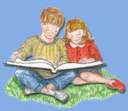 1. Bibliography: Yang, Gene Luen. 2007. American Born Chinese. New York: First Second. ISBN#: 978-1-59643-152-2.
1. Bibliography: Yang, Gene Luen. 2007. American Born Chinese. New York: First Second. ISBN#: 978-1-59643-152-2.2. Plot Summary: Three stories of characters that appear to be unrelated, come together in a surprising conclusion. Dissatisfied with his position as kung fu master and king of all monkeys, Monkey King feels he is worthy to rule among the higher gods. However, the gods are unaccepting and in his arrogance, Monkey King finds himself buried under a mountain of rocks for the next five hundred years. Jin Yang's is the story of a Chinese American who moves to a new neighborhood. Jin immediately feels out of place and friendless in a school of white Americans until Wei-Chen arrives. Comfortable in his Chinese heritage, Wei-Chen does not understand Jin's desire to conform to American culture, eventually driving the two friends apart. Finally, Chin-Kee embodies the characteristics of a negative Chinese sterotype. His American cousin Danny suffers the humiliation of his behaviors to a breakage point that results in an unexpected turn of events that binds these three characters' lives.
3. Critical Analysis: Gene Luen Yang is adept at weaving three story threads, seemingly independent of each other, into a storyline that addresses a serious theme through humor and vivid graphic art that will allure young adults. The tales of Monkey King, Jin Yang, and Chin-Kee unfold in small chapters, building to an ultimate climax that reveals the relationship between three characters that come to embrace and accept themselves in their diversity. A deeper look into American Born Chinese addresses the personal and outside pressures characters face because of their cultural and ethnic differences. This is illustrated in the case of the Monkey King's discontent among the monkeys and desire to be accepted among the more powerful deities, in Jin Yang's feelings of unworthiness in winning the affections of a popular Americal girl, and in Danny's embarrassment of his cousin, Chin-Kee. The comic book feel of this novel is key to the light-hearted delivery and understanding of the common theme. Represented as a graphic novel with strong character appeal, American Born Chinese is an unintimidating read for young adults with a message that can be taken to heart.
4. Review Excerpts:
- Booklist: With vibrant colors and visual panache, indie writer-illustrator Yang (Rosary Comic Book) focuses on three characters in tales that touch on facets of Chinese American life. Jin is a boy faced with the casual racism of fellow students and the pressure of his crush on a Caucasian girl; the Monkey King, a character from Chinese folklore, has attained great power but feels he is being held back because of what the gods perceive as his lowly status; and Danny, a popular high-school student, suffers through an annual visit from his cousin Chin-Kee, a walking, talking compendium of exaggerated Chinese stereotypes. Each of the characters is flawed but familiar, and, in a clever postmodern twist, all share a deep, unforeseen connection. Yang helps the humor shine by using his art to exaggerate or contradict the words, creating a synthesis that marks an accomplished graphic storyteller. The stories have a simple, engaging sweep to them, but their weighty subjects--shame, racism, and friendship--receive thoughtful, powerful examination.
- Library Media Connection: In this graphic novel, three humorous and seemingly unrelated stories keep the reader's attention until they come together at the end. The first story concerns a Chinese-American boy trying to fit in. The second is a retelling of the Chinese fable of the monkey king. Those familiar with the anime/manga Saiyuki will immediately recognize the characters of the monk, water sprite, and boar in the Journey to the West. The third story involves a Chinese cousin who visits an American boy each year. The depiction of the cousin is so painfully stereotypical that you feel guilty laughing. In each story, the central character is unsatisfied with who he is and goes to great lengths to be someone else-with humorous results. The reader might be puzzled as to how the three stories are connected until the conclusion. It's a nice combination of a fable and contemporary stories to convey the wonderful lesson of accepting one's culture and identity with pride. A quick read, this title has engaging art, and at times, funny dialogue. There are some mild sexual references. One of my students, an active graphic novel reader, pronounced it, "Really funny with good characters."
5. Connections:
- Develop a cultural awareness unit. Students may share experiences, traditions, and stories about their own cultures. If possible, invite parents and/or grandparents to visit and share cultural stories and experiences with the class.
- Share literature about children from other cultures living in America and discuss their thoughts.








